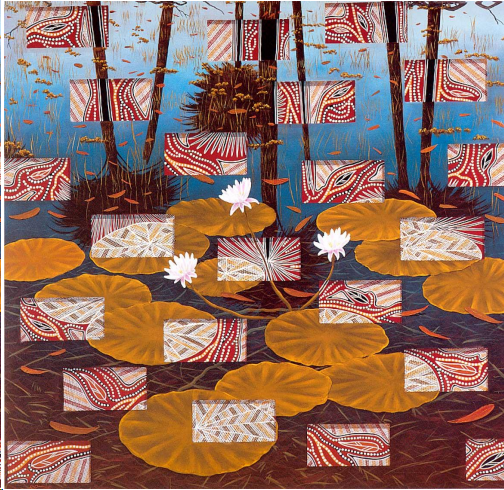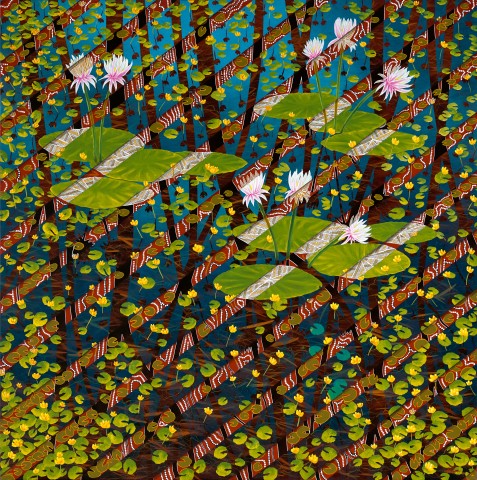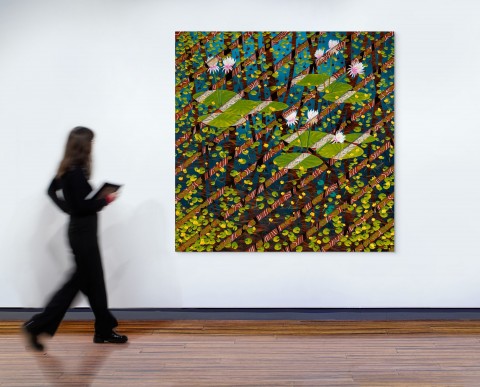YELLOW LILIES, 1993
LIN ONUS
synthetic polymer paint on canvas
182.0 x 182.0 cm
signed lower right: Lin Onus
Gallery Gabrielle Pizzi, Melbourne (label attached verso)
Boston Consulting Group, Melbourne
Private collection, Sydney, acquired from the above in 2008
There and Back: an Exhibition of Recent Paintings and Sculpture by Lin Onus, Gallery Gabrielle Pizzi, Melbourne, 27 July - 4 September 1993
Onus (1).jpg

With visually arresting rhythmic striations, Lin Onus’ expansive Yellow Lilies, 1993 simultaneously presents, two opposing landscape views of a site of great indigenous cultural significance, Gurruwiling, the Arafura Swamp wetlands of central Arnhem Land. Painted at dusk, the sublime surface of Onus’ billabong, dotted with hundreds of water lily plants is still, reflecting the striking black trunks of native gums, a glassy transparency revealing a bed of russet leaflitter. Spliced evenly across the entire painted surface, the integrity of his picturesque Western landscape is compromised – revealed through interstices is the same view painted in colours mimicking bark and natural earth pigments, borrowing the graphic flatness and ceremonial rarrk crosshatched motifs of local Yolngu bark painting. Joining a small and important group of double-image landscape paintings1 featuring overlays or perforations, Onus’ metaphorical dislocations, with almost Magrittean surrealism, disrupt and subvert assumptions on ideologies of representation and the implications of belonging and custodianship they project. Self-consciously, they interrogate the process of representation itself and provide an unwavering reminder that this land is, and always has been, Aboriginal land. The incorporation of dual perspectives in his artworks through postmodern techniques of bricolage was Onus’ light-hearted and often humorous strategy to surmount prejudiced notions of what aboriginal art could and should look like. By 1993, Lin Onus was one of Australia’s best known and well regarded contemporary aboriginal artists, awarded that year a Member of the Order of Australia (AM) in the Queen’s Birthday honours list. He remains acclaimed today for his dedication to fostering cultural understanding through his roles as artist, educator, activist, and administrator.
Onus grew up in the quiet Melbourne suburb of Deepdene within a deeply politically engaged household. He was the only child of William (Bill) Townsend Onus, a Yorta Yorta man and pioneering political activist, and Mary McLintock Kelly, a Scottish woman whom he had met at a Communist Party of Australia rally and married in 1947. Bill and his brother Eric, were instrumental in reforming the Australian Aborigines’ League advocating for indigenous civil and land rights and later driving the 1967 Referendum.2 Throughout the 1950s and 60s, Bill Onus established and ran a successful commercial enterprise, commissioning and selling decorative replicas of traditional implements such as boomerangs and woomeras, as well as Aboriginal-themed souvenirs to busloads of visiting tourists, at his shop, Aboriginal Enterprise in Belgrave, Victoria.3 It was through his early involvement with his father’s crafts and the influence of visiting artists, that the young Lin Onus taught himself painting, and recognised a need for cultural education and renewal amongst urban aboriginal youths.
Onus Alalfura.png

Throughout the 1970s and early 1980s, Lin Onus painted landscapes of his local environs around the Dandenongs, in a Western photorealist style, influenced by the works of older, indigenous artists who had been successful in using a European landscape tradition to depict their ancestral lands: Ronald Bull (1942 – 1979), Revel Cooper (c.1934 – 1983), and Albert Namatjira (1902 – 1959), all of whom had visited the Onus’ family in Melbourne. It was Onus’ later involvement with the Aboriginal Arts Board of the Australia Council, however, that provided a transformative visit to Maningrida, NT in 1986 – a ‘spiritual awakening’4 during which he met Senior Yolgnu artist, Djiwul (Jack) Wunuwun, whose ancestral lands run along the Northern edge of the Arafura Swamp. Over the course of dozens of subsequent pilgrimages to visit Wunuwun, Onus was welcomed into the Murrungun-Djnang clan, initiated into cultural knowledge systems and given permission to use sacred rarrk designs and storylines. Wunuwun’s philosophy of ‘seeing below the surface’ and using artistic hybridity to achieve reconciliation were also shared and adopted by Onus, explored in depth in his late water-and-reflection paintings.5
Yellow Lilies, with its striking dense patterning, oscillates between two interwoven modes of viewing and systems of understanding the world, metaphorically portraying indigenous displacement and erasure. Like the jigsaw motif of Arafura Swamp, 1990, the revelation of an underlying bark design gives primacy to its ancient origins.6 Running perpendicular to the striations, Onus’ black tree trunks unify the two images, indicating that in the impossibility of returning to land of pre-colonisation, the co-existence of multiple and equivalent frames of reference is a sustainable path to progress.
1. These include Jimmy’s Billabong, 1988, overlaid with rarrk, National Gallery of Australia; Arafura Swamp, 1990, with square cut-outs revealing an underlying bark painting, Baillieu Myer Collection; and Barmah Forest, 1994, with mismatched jigsaw piece cut-outs, Australian Heritage Commission, Canberra.
2. ‘William ‘Bill’ Onus’, First Peoples – State Relations, Victoria, 30 September 2019; see https://www.firstpeoplesrelations.vic.gov.au/william-bill-onus (accessed March 2024)
3. Kleinert, S., ‘Aboriginal Enterprises: Negotiating an urban Aboriginality’, Aboriginal History, Australian National University, Canberra, vol. 34, 2010, p. 2
4. Lin Onus, cited in Leslie, D., ‘Earth, spirit and belonging in Australian art’, Spirit in the Land, McClelland Gallery + Sculpture Park, Langwarrin, 2010 – 2011, p. 19
5. Davis, P., ‘In Touch with an artist’s Aboriginality’, Canberra Times, 7 July 1990, p. 21 and Mundine, D., ‘Jack Wunuwun’, Museum of Contemporary Art Australia Handbook, see https://www.mca.com.au/collection/artists/jack-wunuwun/ (accessed March 2024)
6. Neale, M., Urban Dingo - the Art and Life of Lin Onus 1948 – 1996, Queensland Art Gallery, Brisbane, 2000, p. 16
LUCIE REEVES-SMITH

